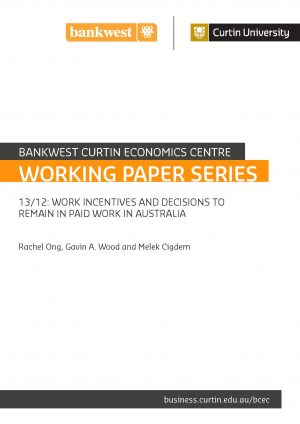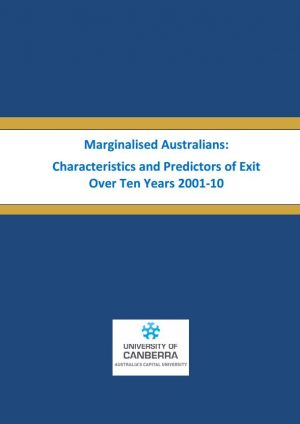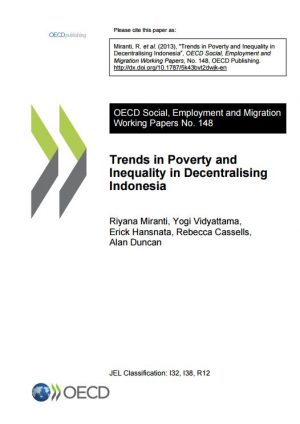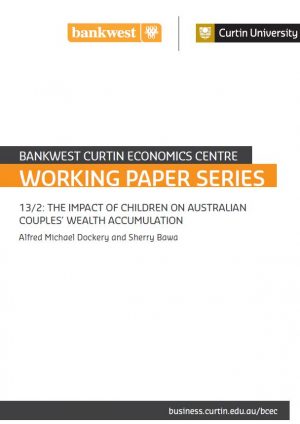Publications
Search results for
Research Theme: Income and WealthX
Parents’ nonstandard work schedules and child well-being
 There is concern that workers are finding it increasingly difficult to balance work and family life and face growing time stress. Working from home is one form of flexibility in working arrangements that may assist workers to juggle work and... Read article
There is concern that workers are finding it increasingly difficult to balance work and family life and face growing time stress. Working from home is one form of flexibility in working arrangements that may assist workers to juggle work and... Read article
 There is concern that workers are finding it increasingly difficult to balance work and family life and face growing time stress. Working from home is one form of flexibility in working arrangements that may assist workers to juggle work and... Read article
There is concern that workers are finding it increasingly difficult to balance work and family life and face growing time stress. Working from home is one form of flexibility in working arrangements that may assist workers to juggle work and... Read article
Is Working from Home Good Work or Bad Work?
 Abstract There is concern that workers are finding it increasingly difficult to balance work and family life and face growing time stress. Working from home is one form of flexibility in working arrangements that may assist workers to juggle work... Read article
Abstract There is concern that workers are finding it increasingly difficult to balance work and family life and face growing time stress. Working from home is one form of flexibility in working arrangements that may assist workers to juggle work... Read article
 Abstract There is concern that workers are finding it increasingly difficult to balance work and family life and face growing time stress. Working from home is one form of flexibility in working arrangements that may assist workers to juggle work... Read article
Abstract There is concern that workers are finding it increasingly difficult to balance work and family life and face growing time stress. Working from home is one form of flexibility in working arrangements that may assist workers to juggle work... Read article
Work Incentives and Decisions to Remain in Paid Work in Australia
 Introduction Lifting workforce participation rates is a key objective of Australian policy-makers. The most recent evidence of this emerged in the lead up to the 2013 Federal election. The Coalition proposed that young Australians unemployed for 12 months or more and receiving... Read article
Introduction Lifting workforce participation rates is a key objective of Australian policy-makers. The most recent evidence of this emerged in the lead up to the 2013 Federal election. The Coalition proposed that young Australians unemployed for 12 months or more and receiving... Read article
 Introduction Lifting workforce participation rates is a key objective of Australian policy-makers. The most recent evidence of this emerged in the lead up to the 2013 Federal election. The Coalition proposed that young Australians unemployed for 12 months or more and receiving... Read article
Introduction Lifting workforce participation rates is a key objective of Australian policy-makers. The most recent evidence of this emerged in the lead up to the 2013 Federal election. The Coalition proposed that young Australians unemployed for 12 months or more and receiving... Read article
The edges of home ownership
 The edges of ownership form a neglected zone between the majority tenure, sustainable owner occupation, and the minority experience, long-term renting. In tenure-divided societies like Australia, the UK and the USA—where there is a stark financial, social and cultural divide... Read article
The edges of ownership form a neglected zone between the majority tenure, sustainable owner occupation, and the minority experience, long-term renting. In tenure-divided societies like Australia, the UK and the USA—where there is a stark financial, social and cultural divide... Read article
 The edges of ownership form a neglected zone between the majority tenure, sustainable owner occupation, and the minority experience, long-term renting. In tenure-divided societies like Australia, the UK and the USA—where there is a stark financial, social and cultural divide... Read article
The edges of ownership form a neglected zone between the majority tenure, sustainable owner occupation, and the minority experience, long-term renting. In tenure-divided societies like Australia, the UK and the USA—where there is a stark financial, social and cultural divide... Read article
Marginalised Australians: characteristics and predictors of exit over ten years 2001-10
 A decade ago a group of ‘marginalised’ Australians were identified; individuals who are characterised by a complex mix of financial, social, and mental health disadvantage. This project has followed up these individuals ten years later, and found that a majority... Read article
A decade ago a group of ‘marginalised’ Australians were identified; individuals who are characterised by a complex mix of financial, social, and mental health disadvantage. This project has followed up these individuals ten years later, and found that a majority... Read article
 A decade ago a group of ‘marginalised’ Australians were identified; individuals who are characterised by a complex mix of financial, social, and mental health disadvantage. This project has followed up these individuals ten years later, and found that a majority... Read article
A decade ago a group of ‘marginalised’ Australians were identified; individuals who are characterised by a complex mix of financial, social, and mental health disadvantage. This project has followed up these individuals ten years later, and found that a majority... Read article
Trends in Poverty and Inequality in Decentralising Indonesia
 As one of the world’s largest emerging economies, Indonesia has experienced rapid economic growth and substantial reduction of poverty over the past three decades, particularly prior to the 1997-98 Asian Financial Crisis. After the crisis, Indonesia entered a new development... Read article
As one of the world’s largest emerging economies, Indonesia has experienced rapid economic growth and substantial reduction of poverty over the past three decades, particularly prior to the 1997-98 Asian Financial Crisis. After the crisis, Indonesia entered a new development... Read article
 As one of the world’s largest emerging economies, Indonesia has experienced rapid economic growth and substantial reduction of poverty over the past three decades, particularly prior to the 1997-98 Asian Financial Crisis. After the crisis, Indonesia entered a new development... Read article
As one of the world’s largest emerging economies, Indonesia has experienced rapid economic growth and substantial reduction of poverty over the past three decades, particularly prior to the 1997-98 Asian Financial Crisis. After the crisis, Indonesia entered a new development... Read article
Trends in the Gender Wealth Gap Among Single Households in Australia 2002-2010
 Abstract This study uses three wealth modules from the Household, Income and Labour Dynamics in Australia Survey to explore the gender wealth gap for single Australian households between 2002 and 2010. The findings indicate significant gender wealth gaps, which have increased over the... Read article
Abstract This study uses three wealth modules from the Household, Income and Labour Dynamics in Australia Survey to explore the gender wealth gap for single Australian households between 2002 and 2010. The findings indicate significant gender wealth gaps, which have increased over the... Read article
 Abstract This study uses three wealth modules from the Household, Income and Labour Dynamics in Australia Survey to explore the gender wealth gap for single Australian households between 2002 and 2010. The findings indicate significant gender wealth gaps, which have increased over the... Read article
Abstract This study uses three wealth modules from the Household, Income and Labour Dynamics in Australia Survey to explore the gender wealth gap for single Australian households between 2002 and 2010. The findings indicate significant gender wealth gaps, which have increased over the... Read article
The Impact of Children on Australian Couples’ Wealth Accumulation
 Abstract Existing estimates of the cost of raising children mainly focus on what parents spend on their children. This paper challenges the conceptual basis for this approach, and instead investigates how the presence of children impacts upon couples’ wealth accumulation using the life-cycle... Read article
Abstract Existing estimates of the cost of raising children mainly focus on what parents spend on their children. This paper challenges the conceptual basis for this approach, and instead investigates how the presence of children impacts upon couples’ wealth accumulation using the life-cycle... Read article
 Abstract Existing estimates of the cost of raising children mainly focus on what parents spend on their children. This paper challenges the conceptual basis for this approach, and instead investigates how the presence of children impacts upon couples’ wealth accumulation using the life-cycle... Read article
Abstract Existing estimates of the cost of raising children mainly focus on what parents spend on their children. This paper challenges the conceptual basis for this approach, and instead investigates how the presence of children impacts upon couples’ wealth accumulation using the life-cycle... Read article
Quality, quantity, spending and prices
 One measure of the change in the “quality” of consumption is the degree to which the consumption basket as a whole moves towards more luxurious goods, away from necessities. We introduce two related measures based on the luxury/necessity distinction. One... Read article
One measure of the change in the “quality” of consumption is the degree to which the consumption basket as a whole moves towards more luxurious goods, away from necessities. We introduce two related measures based on the luxury/necessity distinction. One... Read article
 One measure of the change in the “quality” of consumption is the degree to which the consumption basket as a whole moves towards more luxurious goods, away from necessities. We introduce two related measures based on the luxury/necessity distinction. One... Read article
One measure of the change in the “quality” of consumption is the degree to which the consumption basket as a whole moves towards more luxurious goods, away from necessities. We introduce two related measures based on the luxury/necessity distinction. One... Read article
World food demand
 Long-term projections of global food demand are heavily dependent on which functional form of the food demand equation is used. Given that real incomes can change substantially over the long-term, key elements are the dependence of the income elasticity on... Read article
Long-term projections of global food demand are heavily dependent on which functional form of the food demand equation is used. Given that real incomes can change substantially over the long-term, key elements are the dependence of the income elasticity on... Read article
 Long-term projections of global food demand are heavily dependent on which functional form of the food demand equation is used. Given that real incomes can change substantially over the long-term, key elements are the dependence of the income elasticity on... Read article
Long-term projections of global food demand are heavily dependent on which functional form of the food demand equation is used. Given that real incomes can change substantially over the long-term, key elements are the dependence of the income elasticity on... Read article



